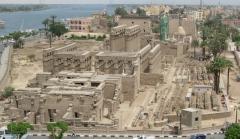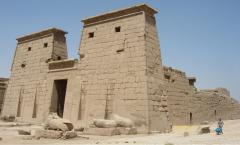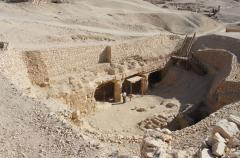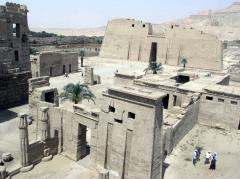The Epigraphic Survey began its long collaboration with the Egyptian antiquities organization, now the Supreme Council of Antiquities (SCA) and the Ministry of Tourism and Antiquities (MoTA), in 1924, initially with documentation work in the mortuary temple of Ramesses III, and we maintain an ongoing commitment to the recording and conservation of all of the monuments that form part of the Medinet Habu complex. Over the years, however, the Survey has also devoted considerable effort to the recording and preservation of inscribed material from other sites, including Karnak, Luxor Temple, the Theban Necropolis, the Saqqara Necropolis (during the 1930s), and the Nubian salvage campaign (during the 1960s). At present, we have ongoing projects, in collaboration with the MoTA, at the following four sites:
Medinet Habu
In 1970 the Epigraphic Survey completed its record of the reliefs and inscriptions in the principal buildings of Ramesses III’s mortuary temple, comprising Medinet Habu Vols. I-VIII. The temple enclosure nevertheless contains a number of lesser monuments, dating both before and after the 20th Dynasty, which still await documentation, and for this reason in the early 1990’s the Chicago House team resumed activity on the site, focusing on documentation of the small 18th Dynasty Temple of Amun with its later extensions. In 1995, a conservation component, funded by ARCE and USAID Egypt, was incorporated into our work on the Amun Temple, focused on cleaning of the painted reliefs within the temple’s inner chambers. Starting in 2006, with a grant from USAID Egypt, this program was expanded to include restoration of the subterranean wells, gateways, and other minor structures within the precinct, as well as cataloguing and conservation of over 4000 loose inscribed stone fragments found throughout the enclosure. Current projects thus include the epigraphic documentation of the small Amun Temple, for which the first volume, Medinet Habu IX, appeared in print in 2009, along with analysis and publication of fragment groups assembled in the on-site blockyard, with several articles on this material now in press. Conservation and restoration initiatives, aside from continued monitoring and restoration of the 18th Dynasty temple, include the dismantling, consolidation, and reconstruction of the sandstone gates of the Roman emperors Domitian (finished in 2016) and Claudius, physical reconstruction of numerous fragment groups, particularly those originating from the Palace of Ramesses III, and the creation of a small open-air museum for display of these reconstructed monuments. Our conservation plan also includes an ongoing training program for young Egyptian conservators employed by the MSA. Current grants include a four-year grant from USAID Egypt starting in 2016 for the preservation, restoration, and development of the southern and western sectors of Medinet Habu, including the western High Gate and House of Butehamun. A grant from the Rockefeller Brothers Fund (RBF) in 2015 allowed us to continue and expand our conservation work at the southern well of Ramesses III. We will continue both the epigraphic documentation and conservation efforts at Medinet Habu on a long-term basis as our primary mission in the years to come.
Luxor Temple
 In the late 1970’s, the Epigraphic Survey applied for and received permission to document the 18th Dynasty reliefs in Luxor Temple, which date mainly to the time of Amenhotep III and his successors. The great Colonnade Hall, with its festival scenes carved during and after the reign of Tutankhamun, was the primary focus of the Chicago House team throughout much of the 1980’s and 1990’s, resulting in the publication of Reliefs and Inscriptions at Luxor Temple, Vols. I-II. Throughout the same period, we have undertaken the systematic cataloguing, conservation, and analysis of the more than 50,000 inscribed stone fragments, collected from all over the Theban region, which are now stored within the Luxor Temple precinct. From 1995, a project funded first by USAID Egypt and ARCE, and then by the World Monuments Fund, permitted proper storage platforms to be created for all of the fragmentary material, emergency conservation measures to be undertaken for the most threatened pieces, and made possible the creation of an on-site open-air museum. It has also been possible to reassemble selected fragment groups in their original locations on the standing walls of the temple. Study and conservation of the Luxor Temple fragment corpus is ongoing, in particular a project to analyze and reconstruct fragments of the Church of St. Thecla, which once stood north of the Pylon of Ramesses II, an undertaking kindly funded by Nassef Sawiris and initiated in 2010. Current initiatives include a new database and digital documentation program for the blockyard utilizing photogrammetric mapping of entire block rows. Within the temple proper, Chicago House partnered with the American Research Center in Egypt from 2005-2008 to facilitate the cleaning, preservation, and documentation of the unique Late Roman fresco paintings, dating to the First Tetrarchy, that are partially preserved in the central section of the monument. In 2013 we began the process of making detailed facsimile drawings of these paintings for definitive publication thereof, as well as of the underlying 18th Dynasty reliefs. An exciting new photogrammetric documentation program - photography and digital drawing - was inaugurated in the Imperial Roman Cult Chamber and adjacent Hall of Offerings in 2018. Our continuing work on both the fragmentary material and the standing monument is part of the Epigraphic Survey’s long-term commitment to the preservation and publication of Luxor Temple.
In the late 1970’s, the Epigraphic Survey applied for and received permission to document the 18th Dynasty reliefs in Luxor Temple, which date mainly to the time of Amenhotep III and his successors. The great Colonnade Hall, with its festival scenes carved during and after the reign of Tutankhamun, was the primary focus of the Chicago House team throughout much of the 1980’s and 1990’s, resulting in the publication of Reliefs and Inscriptions at Luxor Temple, Vols. I-II. Throughout the same period, we have undertaken the systematic cataloguing, conservation, and analysis of the more than 50,000 inscribed stone fragments, collected from all over the Theban region, which are now stored within the Luxor Temple precinct. From 1995, a project funded first by USAID Egypt and ARCE, and then by the World Monuments Fund, permitted proper storage platforms to be created for all of the fragmentary material, emergency conservation measures to be undertaken for the most threatened pieces, and made possible the creation of an on-site open-air museum. It has also been possible to reassemble selected fragment groups in their original locations on the standing walls of the temple. Study and conservation of the Luxor Temple fragment corpus is ongoing, in particular a project to analyze and reconstruct fragments of the Church of St. Thecla, which once stood north of the Pylon of Ramesses II, an undertaking kindly funded by Nassef Sawiris and initiated in 2010. Current initiatives include a new database and digital documentation program for the blockyard utilizing photogrammetric mapping of entire block rows. Within the temple proper, Chicago House partnered with the American Research Center in Egypt from 2005-2008 to facilitate the cleaning, preservation, and documentation of the unique Late Roman fresco paintings, dating to the First Tetrarchy, that are partially preserved in the central section of the monument. In 2013 we began the process of making detailed facsimile drawings of these paintings for definitive publication thereof, as well as of the underlying 18th Dynasty reliefs. An exciting new photogrammetric documentation program - photography and digital drawing - was inaugurated in the Imperial Roman Cult Chamber and adjacent Hall of Offerings in 2018. Our continuing work on both the fragmentary material and the standing monument is part of the Epigraphic Survey’s long-term commitment to the preservation and publication of Luxor Temple.
Khonsu Temple, Karnak
 Since the 1920’s, the Epigraphic Survey has undertaken a number of documentation projects within the great temple complex of Karnak, including the temples of Ramesses III in the first court and in the Mut enclosure, the Bubastite gate, the battle reliefs of Seti I, and the temple of Khonsu, located in the southwest corner of the main temenos. Our work in Khonsu Temple has resulted in the publication of two volumes on the wall reliefs, The Temple of Khonsu Vols. I-II, along with a third volume on the rooftop graffiti by the late Helen Jacquet-Gordon. In 2008 the Chicago House team resumed work on the site in cooperation with the American Research Center in Egypt and the Supreme Council of Antiquities. The focus of the present documentation program is the large corpus of inscribed blocks, originating from earlier monuments, which were used as building material when the present temple was built during the reign of Ramesses III. The foundations, floors, walls, columns, and pylons of Khonsu Temple consist almost entirely of reused fragments, many of which still bear their original decoration; and some of this decoration is still visible, exposed in the partially damaged 20th Dynasty walls, or reachable through cracks in the walls and flooring. Our current task is to document as many of these pieces as possible while they remain accessible. So far we have identified groups of material from other known monuments, such as Amenhotep III’s mortuary complex and that of Ay and Horemheb on the west of the Nile, but we have also discovered fragments of previously unknown structures, the most important of which appears to be an older Khonsu Temple, constructed during the 18th Dynasty, expanded during the 19th Dynasty, and then completely dismantled under Ramesses III, its blocks re-used to construct the present monument. By 2015, we had completed the documentation of over 200 in situ blocks in the foundations, floors, and walls, and we have registered nearly 300 loose fragments found in and around the temple. The goal in upcoming seasons is to complete the documentation of all accessible reused fragments in the upper walls, roof areas, and pylons, material that will continue to enrich our knowledge of the history of Karnak and of the monuments of Thebes.
Since the 1920’s, the Epigraphic Survey has undertaken a number of documentation projects within the great temple complex of Karnak, including the temples of Ramesses III in the first court and in the Mut enclosure, the Bubastite gate, the battle reliefs of Seti I, and the temple of Khonsu, located in the southwest corner of the main temenos. Our work in Khonsu Temple has resulted in the publication of two volumes on the wall reliefs, The Temple of Khonsu Vols. I-II, along with a third volume on the rooftop graffiti by the late Helen Jacquet-Gordon. In 2008 the Chicago House team resumed work on the site in cooperation with the American Research Center in Egypt and the Supreme Council of Antiquities. The focus of the present documentation program is the large corpus of inscribed blocks, originating from earlier monuments, which were used as building material when the present temple was built during the reign of Ramesses III. The foundations, floors, walls, columns, and pylons of Khonsu Temple consist almost entirely of reused fragments, many of which still bear their original decoration; and some of this decoration is still visible, exposed in the partially damaged 20th Dynasty walls, or reachable through cracks in the walls and flooring. Our current task is to document as many of these pieces as possible while they remain accessible. So far we have identified groups of material from other known monuments, such as Amenhotep III’s mortuary complex and that of Ay and Horemheb on the west of the Nile, but we have also discovered fragments of previously unknown structures, the most important of which appears to be an older Khonsu Temple, constructed during the 18th Dynasty, expanded during the 19th Dynasty, and then completely dismantled under Ramesses III, its blocks re-used to construct the present monument. By 2015, we had completed the documentation of over 200 in situ blocks in the foundations, floors, and walls, and we have registered nearly 300 loose fragments found in and around the temple. The goal in upcoming seasons is to complete the documentation of all accessible reused fragments in the upper walls, roof areas, and pylons, material that will continue to enrich our knowledge of the history of Karnak and of the monuments of Thebes.
Tomb Of Nefersekheru (TT 107)
 In the years 1959-1970, the Epigraphic Survey added to its program the documentation of the tomb of Kheruef (TT 192), a senior courtier of the reign of Amenhotep III, whose beautiful reliefs, carved in limestone, exemplify the high standard of artistic achievement that characterized the late 18th Dynasty. Interest in stylistic and historical parallels from the same period, along with our objective of preserving the information contained in monuments that are particularly threatened with damage or destruction, has led the Chicago House team to undertake a program in the nearby tomb of Nefersekheru (TT 107), a contemporary of Kheruef and steward of Amenhotep III’s jubilee palace at Malqata. The construction of Nefersekheru’s tomb, though planned to be as large as that of Kheruef, was never completed, and only a small section of the reliefs on the tomb’s façade were carved before the monument was abandoned. The few completed scenes, however, exhibit some of the finest relief carving ever executed in ancient Egypt, comparable to that of Kheruef’s tomb and of the well-known tomb of Ramose. These reliefs are unfortunately in very poor condition, the limestone cracked and fractured by a combination of seismic movement and salt decay. The tomb thus merits special attention, so we began a program of photography and facsimile drawing in the tomb in 2010, the goal of which is the complete documentation of the surviving decoration and of the tomb’s architecture, prior to systematic structural consolidation of the monument and conservation of its decorated surfaces. Epigraphic work and architectural survey of the tomb have been ongoing, with facsimile drawing of the reliefs completed in 2016, and collation of the beautiful drawings completed in 2020. Chicago House received permission to start the clearance of the tomb in 2019, and recovered numerous fragments of the shattered doorjambs that fell just inside the doorway. Recovery, conservation, and digital documentation of these fragments are currently underway.
In the years 1959-1970, the Epigraphic Survey added to its program the documentation of the tomb of Kheruef (TT 192), a senior courtier of the reign of Amenhotep III, whose beautiful reliefs, carved in limestone, exemplify the high standard of artistic achievement that characterized the late 18th Dynasty. Interest in stylistic and historical parallels from the same period, along with our objective of preserving the information contained in monuments that are particularly threatened with damage or destruction, has led the Chicago House team to undertake a program in the nearby tomb of Nefersekheru (TT 107), a contemporary of Kheruef and steward of Amenhotep III’s jubilee palace at Malqata. The construction of Nefersekheru’s tomb, though planned to be as large as that of Kheruef, was never completed, and only a small section of the reliefs on the tomb’s façade were carved before the monument was abandoned. The few completed scenes, however, exhibit some of the finest relief carving ever executed in ancient Egypt, comparable to that of Kheruef’s tomb and of the well-known tomb of Ramose. These reliefs are unfortunately in very poor condition, the limestone cracked and fractured by a combination of seismic movement and salt decay. The tomb thus merits special attention, so we began a program of photography and facsimile drawing in the tomb in 2010, the goal of which is the complete documentation of the surviving decoration and of the tomb’s architecture, prior to systematic structural consolidation of the monument and conservation of its decorated surfaces. Epigraphic work and architectural survey of the tomb have been ongoing, with facsimile drawing of the reliefs completed in 2016, and collation of the beautiful drawings completed in 2020. Chicago House received permission to start the clearance of the tomb in 2019, and recovered numerous fragments of the shattered doorjambs that fell just inside the doorway. Recovery, conservation, and digital documentation of these fragments are currently underway.


